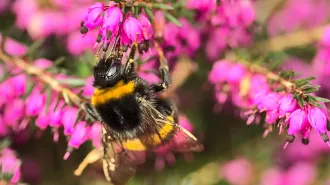Fighter-pilot dogfights no longer blaze across the night skies of Europe, but other fliers may still duel to the death up there. Researchers in Spain propose that bats hunt down migrating birds in midair.
The biggest bat in Europe, the greater noctule, or Nyctalus lasiopterus, eats many birds during the spring and fall migrations, says Javier Juste of Doana Biological Station in Seville. He and his colleagues reached that conclusion after analyzing 14,000 bat droppings during the course of a year.
“It’s the only bat known to get the profit of migrating birds,” Juste says.
Birds by the millions stream over Europe between winter havens in Africa and northerly breeding grounds. For a predator, the mass of birds is “a big, big chocolate bar coming by,” Juste says.
Most of the world’s bats dine on insects or fruit. Yet a handful can take on bigger and livelier prey, swooping down to pluck fish out of the water, silence a frog in midcroak, or grab a lizard off a wall. Around a dozen bat species, mostly in the tropics, snatch roosting birds from their perches, says Juste.
He suspects that the greater noctule doesn’t wait for its meal to come home to roost. Several lines of evidence suggest that this bat attacks birds on the wing, say Juste, his Doana colleague Carlos Ibez, and their coauthors in the Aug. 14 Proceedings of the National Academy of Sciences.
Three noctule populations take advantage of birds’ seasonal migrations, the researchers report. As many as 45 percent of the analyzed droppings carried feathers during the March-to-May and August-to-November runs. On two occasions, researchers found bats with, or near, identifiable bits from a
European robin or a warbler. In June and July, the bats went back to eating insects, and barely 1 percent of bat droppings had feathers.
Several traits suggest that the greater noctule specializes in long-range hunting, the researchers find. The bat spreads long, relatively narrow wings built more for speed than for close-range maneuverability in forests.
Also, the echolocation calls that the team recorded are typical of those used by open-air species.
Though low for a bat, the calls are still too high in pitch for birds to hear, Juste adds. As he pictures it, the bats “take advantage of millions of birds flying at night, tired, blind, probably flying mechanically, trying to get to Africa.”
Juste speculates that a bat swoops onto an unsuspecting bird and must disable it before plummeting to the ground. “The bat has very strong neck muscles and formidable teeth,” he says, so he suspects that a few bites do the job.
The bats may even eat the birds in midair, according to Juste. The team found no heaps of bird leftovers under the bats’ roosts.
After considering how bats eat large, airborne beetles, Juste suspects that the greater noctules strip off a bird’s wings. “They take a couple of big bites of the breast and then throw the bird away,” he suggests.
Bat researcher Richard Laval in Monteverde, Costa Rica, calls the suggestion of airborne hunts “fascinating.” The paper presents “amazing data,” though the question of how the bat catches the bird remains open, he says.
Kent Rylander of Texas Tech University in Lubbock adds, “I’m a little surprised that the scientific community has been so long in discovering this obvious niche for nocturnal bats.” He calls the team’s arguments “convincing.”
Juste recognizes the difficulties of making the case by indirect evidence. For skeptical researchers, he says, “we have plenty of bat droppings, and they are more than welcome to look at them.”






